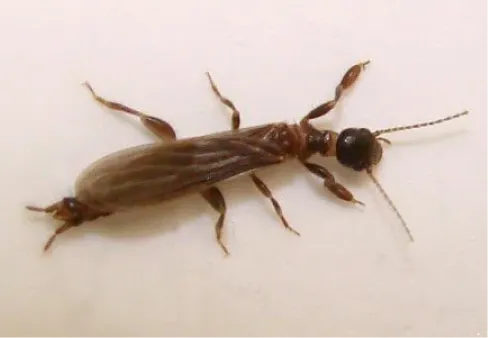Wood-boring beetles are persistent insects that tunnel through structural lumber. They create distinctive exit holes and fine powder frass in infested wooden structures.

Wood-boring beetles, particularly powderpost beetles, are significant wood-destroying insects in Southern California. These beetles can cause extensive damage to structural timber, furniture, and other wood products, often remaining undetected until significant damage has occurred.
These persistent pests have a unique life cycle that can span 1-5 years, with larvae doing most of the damage as they tunnel through wood. Adult beetles emerge in spring and summer, leaving distinctive small, round exit holes. The presence of fine, powdery frass (wood dust) near these holes is a telltale sign of infestation. Their ability to reinfest the same wood and their preference for hardwoods with high starch content makes them particularly problematic in both new construction and older structures. The long development period and hidden nature of their damage often means infestations aren't discovered until significant structural compromise has occurred.

Anatomy of Wood-boring Beetles
Wood-boring beetles have specialized features adapted for their wood-boring lifestyle.
- Head
- Antennae
- Thorax
- Elytra
- Legs
- Wings

How to Identify Wood-boring Beetles
Adult beetles are dark brown to black, 1/8 to 1/4 inch long, with elongated, narrow bodies. Look for small, round exit holes, fine powder frass, and adult emergence holes in wood surfaces.

Habitat of Wood-boring Beetles
These beetles infest hardwood lumber, flooring, furniture, and wooden tools. They prefer wood with higher moisture content (above 6%) and proper grain structure, particularly in undisturbed areas.

Warning Signs of Wood-boring Beetles
Key indicators include pinhead-sized holes in wood surfaces, fine powder frass, adult emergence, and weakened wood. Listen for clicking sounds and watch for surface blistering.
Warning Signs of Wood-boring Beetles
Key indicators include pinhead-sized holes in wood surfaces, fine powder frass, adult emergence, and weakened wood. Listen for clicking sounds and watch for surface blistering.







Control Methods for Wood-boring Beetles
Control methods include wood treatments with borates, surface sprays, and in severe cases, fumigation. Prevention focuses on moisture control, wood sealing, and proper storage practices.
Look for small round exit holes in wood, fine powder (frass) near holes, and tunneling patterns beneath the wood surface. Adult beetles emerge leaving distinct holes.
Wood-boring beetle damage often isn't visible for 2-5 years after initial infestation, as larvae develop slowly inside the wood.
Different species prefer different woods, but most attack hardwoods with high starch content. Some species specifically target softwoods or processed lumber.
Yes, adult beetles can fly to infest new wood sources. They're also spread through infested lumber, furniture, or wooden items.
Use treated or sealed wood, maintain proper wood moisture levels, and inspect wood items before bringing them inside.
Some species can reinfest the same wood, while others only infest wood once. The ability to reinfest depends on the species and wood conditions.
We Provide the Care toEliminate Termites and Pests For Good
Protecting your home from pests shouldn't be complicated. The Termite Guy makes it simple with wholistic solutions to inspect, treat, and restore your home back to perfection. With a 5 year pest-free warranty and over 25 years of success, we ensure every home is safe and secure.

Inspections

Treatments

Damage Repair
.avif)
.avif)
.avif)
.avif)











































